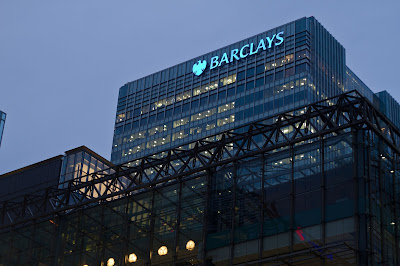Barclays Makes its Move into Familiar Places
We discussed recently here
in Financial Regulation Matters that
Edward Bramson, the activist investor attempting to change the direction within
the British bank Barclays, was attempting to have his fellow shareholders
approve his ascension to the Board of the Bank on account of wanting to stem
the continued development of the investment arm of the bank. In this post, we
will look at what happened and assess the latest news which shines a light on
his reasoning.
As was widely expected, Bramson lost
his bid to join the Board. Only 13% of the votes cast were for Bramson’s
resolution although, as stated above, this was widely expected. Whilst there
was an unexpected development in the AGM – 30% of shareholders voted against
its remuneration report – the focus on Bramson is important. The Guardian reports how opinion was
split concerning Bramson’s motives, with some investors agreeing that there was
a need to ‘wake
this board of directors up’, but others stating that ‘bear in mind he’s
making money for himself and his investors’. Outgoing chair John McFarlane said
of Bramson that he did not support his appointment to the board ‘particularly
as we have just recovered from a turbulent past’. This casts an aspersion on
Bramson, but if we reverse it and assess today’s news, many more questions are
raised.
The Guardian’s Nils
Pratley asked, after the Barclay’s AGM, ‘Barclays
wins battle with Bramson, but why did he bother with it?’ Perhaps there are
many reasons, but today’s news that Barclays are about to make an assault on
the US residential mortgage-backed securities market raises a number of alarms.
Just as McFarlane declared that the troubled past is behind them, and
particularly seems as the Qatar-based investigation has essentially come to a
close and more than £2 billion has been paid in fines, it is rather surprising
that the bank would delve head first into the market that brought it into so
much disrepute. Perhaps it is not such a surprise. The bank have assembled a
team of 140 securitisation bankers and traders, working under former Bear
Sterns and RBS securitisation supremo Scott Eichel, and their rhetoric is very
familiar. The bank’s head of global markets, Stephen Dainton, said recently
that ‘this
was a £500 million business for Barclays in terms of revenues last year, when
global peers are making £1 billion a year, so for us to get to £500 million
additional revenue over 3 years… should be achievable’. This was, naturally,
adjoined to the sentiment that it is for
society, and will not be the same as the pre-Crisis hubris that brought the
system to its knees. Reuters, in its
reporting of the move, suggested that Barclays believe the money will be made
from the ‘the
intended purpose of securitisations – providing companies and homeowners
improved access to credit by pooling the risk of lending to them – rather than
making bets on the markets’. Yet, the reality is as clear as day. Under
President Trump, the sentiment of deregulation being the key to moving forward
is being advanced to all market participants, with Barclays being ‘hopeful
signs of softening U.S. regulations underpinning the securitisation industry
could help to consolidate and expand its burgeoning market share’. Eichel, for
his part, continues this narrative by declaring that ‘we’re
doing what regulators want banks to do, which is help customers to get
financing so businesses can grow, and help investors who buy these bonds to get
the liquidity they need’. This noble pursuit is right in line with the
preparatory sentiment that precedes a systemic assault on the marketplace –
essentially, it will be the regulators’ fault, not the banks. The fact that Jes
Staley is under increasing pressure for the investment arm to come good on the
back of his consistent support in the face of opposition will not be mentioned.
It will be very unlikely that, if the move pays off as Eichel hopes (and
probably knows) that it will, Barclays will be happy with measured growth in
comparison to its competitors; this will not be mentioned. Also, if Barclays
can find an extra £500 million in revenues from the marketplace within 3 years,
why would JPMorgan Chase, Credit Suisse, and the others not seek to find an
extra £500 million a year? This is how a bubble is developed, with a fervent clamour
for the riches on offer. If we take a moment and look at this story closer,
perhaps the answer to ‘why did Bramson bother’ is abundantly clear. Or perhaps
not. Nevertheless, the entrance of Barclays into an increasingly-deregulated
marketplace is a warning sign of things to come. The same sentiment as has been
displayed many times in this blog potentially rings true again – is the world
ready for another financial onslaught just 10, 11, or 12 years after that last
onslaught?
Keywords – Banking, Barclays, Mortgages, securitisation, @finregmatters.





Comments
Post a Comment